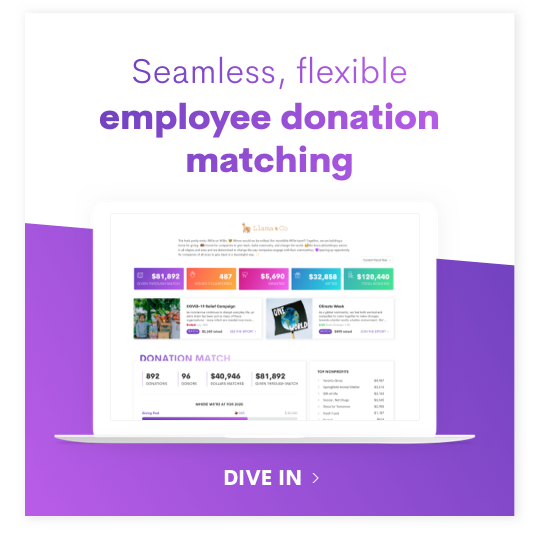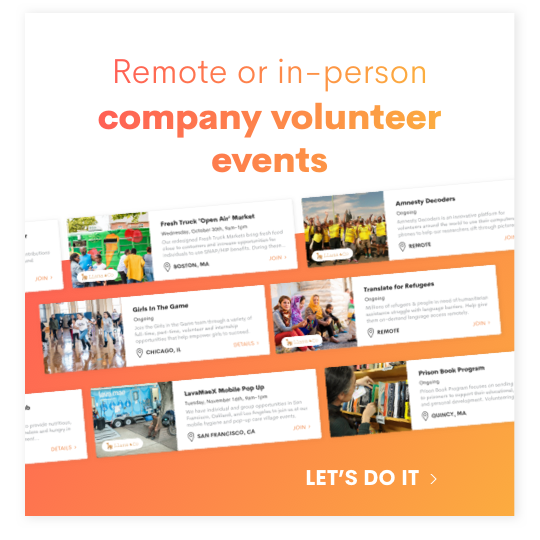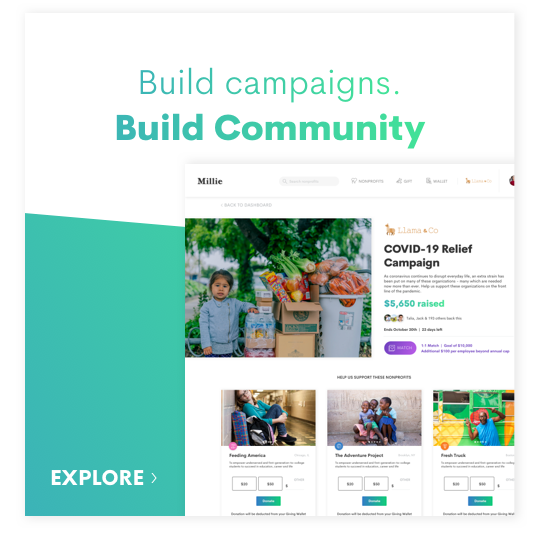About $5 billion in charitable donations go through the workplace every year. Have you ever wondered why some companies can squeeze every ounce of charitable engagement from employees? There’s a good chance that at the heart of most successful strategies, you’ll find a donation matching program at work.
But what are these programs, and how can you create one yourself? Here’s everything you’ll need to know about employee fundraising campaigns that make your employees feel connected to the nonprofits around them.
What Does “Matching Your Donation” Mean?
Let’s start with the most straightforward concept. When you create corporate gift matching programs, you’re essentially telling your employees, “Hey. We like this charity. If you like it, too, we’d love for you to donate. If you do, we’ll donate a matching amount.” When you match donations, it works that simply: an employee can feel like every dollar they give is immediately multiplying in terms of its impact.
Do you have to double the donation? No. Doubling the donation is probably one of the most common misconceptions among people donating to nonprofit charities. Even before they sign donation forms or look into matching contributions, they figure that a 100% match will be too cost-prohibitive. But that’s not necessarily the case.
With a matching gift program platform like Millie, you’ll be free to set your parameters. Here’s where you’ll learn that corporate matching gift programs don’t always have to “double-up” on matching donations. Instead, you might be able to offer something even more impactful, such as 10% in addition to a contribution. Or 50%.
Either way, you’ll create a powerful incentive for your employees. If they believe in a cause and they want to donate, they’ll feel more inclined to put some of their money on the line when they know that your corporate giving programs are going to amplify their gift.
Why are Matching Donations Important?
One word: engagement. You can do a lot to promote a matching gift program. You can advertise it on social media. You can send newsletters to boost employee outreach. You can talk about the amount of money that your corporate leadership has already donated. But ultimately, it comes down to this:
Are you incentivizing your employees to donate?
Corporate philanthropy can only help fund eligible nonprofits if it generates a meaningful amount from employees’ donations. And the way to do that is to create a reason for employees to get out their credit cards.
It isn’t just for the donations, either. One survey found that 71% of employees want to work somewhere where there’s a culture of charity and volunteering.
What does that mean? As it turns out, it’s not only about the donation amount. It’s about your willingness to engage with employees. It’s about the priority you place on campaigns like employer matches and matching donation programs. Are you involved in charity? Are you engaging your employees with matching programs? It’s not just an issue of how much money you’re spending to create those employer matches.
Ultimately, it’s about showing employees—and the world around you—that you care.
The Power of Matching Donations
Company matches have a unique persuasive power about them. When an employee finds out that you’re putting your money where your mouth is, it changes their perception of a fundraising campaign. That can translate to a tremendous amount of employee engagement.
Yes, it’s probably more powerful if you can contribute more to your donation matches. However, you may be surprised to find that any amount you pledge to match can positively affect employee morale. Employees will use corporate retirement matching because it benefits them. But there are a lot of good people out there, and they’re willing to put money down when they know that a corporate matching program can benefit other people, as well.
But it’s not only about the money you put down. It would help if you also had a way to let employees contribute to the causes they care about. 30% of employees told a survey that one reason they don’t donate at work is simple: they can’t find their causes.
This can put the employer in a bind. How do you open your corporate social responsibility efforts to new, worthy causes, such as community food bank programs? That’s where your donation process platform comes in:
How Do I Set Up a Donation Match Program? What Kind of Matching Gift Software Should I Use?
It all sounds well and good. So how do you execute an effective donation match program?
Your easiest bet? Invest in a platform that takes care of everything for you, including:
- Providing structure. . It would help if you didn’t have to sweat over a problematic, self-made platform for matching donations. Nor should you have to use old-school methods. You’ll want a platform that makes donation matching automatic, allowing you to set a budget with a cap limit. This will help you predict exactly how much your company needs to set aside for the program.
- Access to multiple causes. Give your employees options. Maybe there’s a food bank out there that’s near and dear to your employees’ hearts. How will you find out unless you add that food bank to your platform? Seek out a platform like Millie, which will give your employees more options for finding the engagement they want.
- Automating the match program. This is the 21st century, after all. When an employee contributes to their Millie portal, your software can kick in and automatically create the match. It will also notify the employee about the match, ensuring that they’re fully invested when they read the follow-up.
- Creating a donation page. A donation page, or even a search tool, can sometimes make the difference between whether an employee decides to give or not, since it streamlines the giving process. Your platform can – and should – be capable of providing it all.
- Matching gift information. Let employees scroll through a matching gift database to see which charities are eligible. Let them know the matching gift opportunities that are in front of them. They’ll like feeling like they’re in the driver’s seat, leading to more engagement.
- Reducing friction. “Friction” means the more complicated you make a sale, the more likely an online buyer is to leave. The same concept applies to your donation submission process. An online donation should be easy to achieve; don’t make your employees work for it.
Issues like eligibility and hosting fundraisers and match amounts and match-eligible rules can sound complicated when you try to do everything independently. With Millie Giving, you won’t have to do complex math like figuring out your ideal gift ratio, and you don’t have to hire a full-time consultant to manage everything for you.
Instead, everything will be laid out neatly so you can create a donation matching program that makes sense for your employees. With the right software in hand, you can automate everyone’s donations—from board members to every employee. Automate it all to become one of the top matching gift companies in your area—or even well beyond it.
Fortune 500 companies have long since discovered that fundraising and donation matching is a great way to boost employee engagement—with more than 65% of them offering corporate matches. Plus, tens of thousands of smaller businesses incorporate matching gifts as well, making this an increasingly popular choice for companies of all shapes and sizes.
Employees need to feel that the work they’re doing is essential. And when it comes down to it, there may be no more effective fundraising strategy than announcing to your employees that you’ll match what they put down. You may be surprised to find out how many donors’ gifts you were able to impact.



